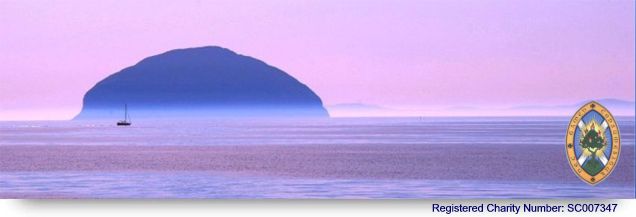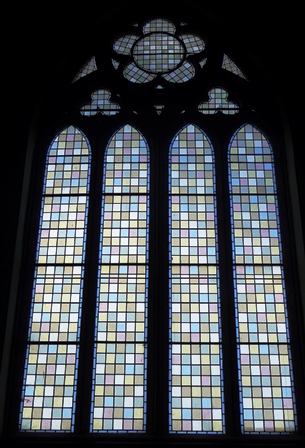
History
Girvan Old / North Parish Church
The old medieval Kirk of Girvan was dedicated to St. Cuthbert in the 13th century. This tiny single cell building, which once stood in the Old Street cemetery, served the faithful for 500 Years until a new 'T-plan kirk was built in the centre of Church Square in 1770.
Our present North Parish Church had the memorial stone laid by the Countess of Stair on Saturday 6th October 1883, and opened for worship in 1884 as The Girvan Old Parish Church of St Cuthbert. We became North Parish in 1973 with the union of Old and St AndrewsNorth Parish Church was opened for worship, in 1884 as The Girvan Old Parish Church ofSt Cuthbert. We became North Parish in 1973 with the union of Old and St Andrews.
In style and plan the Church is typical of the Gothic revival which by the 1880s had outstripped its Classical rival. Its most attractive Gothic exterior has a graceful spire which rises 150 feet in height and must surely be the very finest in the whole of Ayrshire.
On the inside we find a pleasantly familiar Scottish
Presbyterian arrangement,
 thankfully retained in spite of the trendy
movement of the early years of the last century when the pulpits of so
many churches were moved to a side position.
thankfully retained in spite of the trendy
movement of the early years of the last century when the pulpits of so
many churches were moved to a side position.
With a gallery around three walls and a centrally positioned pulpit, it
could very well be described as a galleried hall church in Gothic dress.
A two manual Brinnley and Foster pipe organ was gifted to the. Church in 1884 by Mr Thomas McKechnie at a cost of £750. Unfortunately, essential repairs were considered too costly in 1973 and it was replaced by an Allen electronic instrument.
One of the principal features of the Church is its
painted
 ceiling which is symbolic of the Creation. Shells and seaweed
represent the sea bed and undulating lines the surface of the sea. The Earth
is represented by the flowers of the field and the ceiling is decorated with
heavenly stars.
ceiling which is symbolic of the Creation. Shells and seaweed
represent the sea bed and undulating lines the surface of the sea. The Earth
is represented by the flowers of the field and the ceiling is decorated with
heavenly stars.
In 1926 an attempt was made to have the ceiling painted but fortunately this proposed act of vandalism was defeated and the ceiling was preserved in its original state.
Although the Church was built at a time when Scottish stained glass and the
Glasgow Studios in particular enjoyed a worldwide reputation for excellence,
all windows were originally glazed with plain glass.
But not for long. In 1889 the famous Edinburgh firm of James Ballantine and
Sons were commissioned to design and execute two stained glass windows for
the South Transept, and a year later, two more for the North Transept.
 The windows in the South Transept were presented by Mr Robert Cunningham of
Glendouglas, Jedburgh, in memory of his relatives, the brothers Robert and
Thomas McKechnie. Those in the North Transept were erected by the
congregation in memory of 'Reverend William Corson, Minister of this Parish
from May 1848 to December 1887.
The windows in the South Transept were presented by Mr Robert Cunningham of
Glendouglas, Jedburgh, in memory of his relatives, the brothers Robert and
Thomas McKechnie. Those in the North Transept were erected by the
congregation in memory of 'Reverend William Corson, Minister of this Parish
from May 1848 to December 1887.
In the left window of the south Transept, Mary Magdalene sinks to her knees
as she realises that she is speaking to Jesus and not to the gardener. Her
hands stretch out, together in an act of reverence. Jesus, with hand raised,
tells her; 'Go to my brethren, and say unto them, I ascend unto, my Father,
and your Father; and to my God and you’re God. (St John 20:17)
The window on the right depicts Jesus seated at table breaking bread. His
two companions gasp in surprised recognition as they realise that they have
walked to Emmaus and had supper with Jesus of Nazareth who was crucified.
'And it came to pass, as he sat at met with them, he took bread, and blessed
it, and broke, and gave to them. And their eyes were opened, and they knew
him; and he vanished out of their sight.' (St. Luke 24:30-31)
In the North Transept, the window on the left depicts John the Baptist, who
is easily identified by his raiment of camel's hair' and long reed cross.
Jesus is standing at the back of a small gathering which John the Baptist
addresses with the words: 'Among you stands one whom you do not know, even
he who comes after me, the thong of whose sandal I am not worthy to untie.,
(St John 1:27)
The second window portrays Jesus seated by the Sea of Tiberias. A small boat
can be seen in the distance Peter stands before Jesus, his hands clasped as
if imploring Jesus to believe him: 'Lord, thou knowest all things; thou
knowest that I love thee. Jesus gestures towards the sheep as he charges
Peter to, Feed my sheep., (St John 21:17)
In 1987 a decision was taken to convert the North Transept into a Side
Chapel. Contributions, many in memory of loved ones, were received from
members and friends, and over 150 names are recorded in a Book of
Remembrance which is kept, available for all to see, in the Chapel.
The Side Chapel, now more aptly referred to as The Memorial Chapel, was
dedicated to the Glory of God on Sunday 27th December 1987 by The Reverend
Charles Johnston M A, Clerk to the Presbytery of Ayr.
Looking back over one hundred years, it is quite staggering to be reminded of just how much costs have risen. The Church was built in 1884 for just £4,500 and the Hall for £650, a total of only £5,150. By comparison, repairs to the large west window, which were undertaken in 1991, when three mullions needed to be replaced, cost over £20,000.
